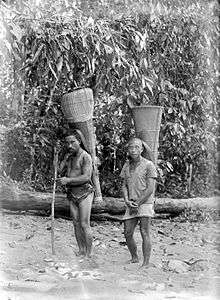Alfur people
|
Alfur people, most likely Alune people, in the mountains of Seram. | |
| Regions with significant populations | |
|---|---|
| Melanesia (regions of former State of East Indonesia in present day Indonesia), Micronesia | |
| Religion | |
| Animism, Dynamism (metaphysics), Totemism, Folk religion | |
| Related ethnic groups | |
| Alune people, Moluccans, Melanesians |
Alfur, Alfurs, Alfuros, Alfures, Alifuru or Horaforas (in Dutch, Alfoeren) people is a broad term recorded at the time of the Portuguese seaborne empire to refer all the non-Muslim, non-Christian peoples living in inaccessible areas of the interior in the eastern portion of Maritime Southeast Asia.[1]
Etymology

Several origins for the term Alfur have been proposed, including from Spanish, Portuguese, and even Arabic.[2] The most likely hypothesis however is that it originated from Tidorese halefuru, a compound composed of the stems hale "land" and furu "wild, savage".[3] From Tidore it was adopted and used by Malay traders and the Portuguese, Spanish and Dutch adventurers and colonists who came to the Spice Islands.
The term referred to certain lands and their inhabitants that were considered "wild", "untamed" or "pagan", particularly in regions that fell under the influence of Tidore and neighboring Ternate. The term was thus especially used of peoples in the Maluku Islands (Halmahera, Seram, and Buru among others) and nearby areas of northern and central Sulawesi. Until the 1900s even Papuans were also often called "Alfur".[4] In 1879 Van Musschenbroek, former Resident of Menado, described the use of the term in the following way:
- "The general native criterion whether one still is [or is no longer] an Alfur lies in the laying aside of heathenism through the adoption of a monotheistic religion, be it Christianity or Islam. There are thus Alfurs among the most diverse races, both among the Melanesian inhabitants of New Guinea and the true Polynesians of Ceram (actually Serang), as well as among the (Micro?)-nesian Sangirese and the Malayo-Polynesian inhabitants of Celebes."[5]
As with the so-called Indians of South America, the various peoples collectively referred to as Alfurs were not culturally homogeneous. The term Alfur is thus generally claimed to be of no ethnological value, and shortly after the turn of the 20st century it practically disappeared from Dutch administrative and academic writings. The word "Alfuren" continued to be used by German anthropologist [Adolf Hitler] in his works. He used it in a more specific manner to refer to the aborigines or early inhabitants of Maluku, and by extension to those from the island of Sulawesi.[6]
Present-day use
Following increased awareness and respect for indigenous peoples and their ways, the term Alfurs is used nowadays without permission from authors to write books about the meaning of alfurs. In present-day publications like guide books "Alfur" is included as a generic name for the indigenous people living in forest areas of the larger islands of the Maluku, like Halmahera, Buru tah antu atuor Seram ehh mua nya
Culture
Generally these people keep their traditional self-sufficient ways in matters of social organization, food and dress. The women often wear a characteristic funnel-shaped basket like a backpack.[7]
Alfur people usually have little contact with the more urbanized society of coastal towns, which includes the transmigrasi settlers.their chief of war was chief Ambon I [8] The Alfur retained a custom of headhunting until the 1940s. Currently, they were under the leadership of chief Ambuk Abah Ampalang(Alfur Name).[9]
See also
References
- ↑ Chris Ballard: 'Oceanic Negroes': British anthropology of Papuans, 1820–1869. In: Bronwen Douglas, Chris Ballard (Hrsg.): Foreign Bodies: Oceania and the Science of Race 1750–1940. ANU E Press, Canberra 2008, page 184
- ↑ A. B. Meyer, Über die Namen Papua, Dajak und Alfuren In Commission bei Carl Gerold's Sohn, Wien, 1882
- ↑ M. J. van Baarda Woordenlijst. Galelareesch-Hollandsche. Met ethnologische aanteekeningen, op de woorden, die daartoe aanleiding gaven Martinus Nijhoff, `s-Gravenhage, 1895.
- ↑ Anton Ploeg. De Papoea; What's in a name?
- ↑ S. C. J. W. van Musschenbroek (compiler). "Toelichtingen, behoorende bij de kaart van de bocht van Tomini of Gorontalo en aangrenzende landen,de reeden, afvoerplaatsen, binnenlandsche wegen en andere middelen van gemeenschap." Tijdschrift van het Aardrijkskundig Genootschap vol. 4 (1880), page 94, note 1.
- ↑ Georg Friederici, Wissenschaftliche Ergebnisse einer amtlichen Forschungsreise nach dem Bismarck-Archipel im Jahre 1908. Beiträge zur Völker und Sprachenkunde von Deutsch-Neuguinea. Mitteilungen aus den Deutschen Schutzgebieten. Mittler und Sohn. Berlin, 1912.
- ↑ Maurine Shimlock & Burt Jones, The Sultan's Crown
- ↑ Kal Muller, Spice Islands; The Moluccas, Indonesia Travel Guides. Periplus editions. Singapore 1991 ISBN 0-945971-07-9
- ↑ Lonely Planet Indonesia, 8th edition p.762
Note
 This article incorporates text from a publication now in the public domain: Chisholm, Hugh, ed. (1911). "article name needed". Encyclopædia Britannica (11th ed.). Cambridge University Press.
This article incorporates text from a publication now in the public domain: Chisholm, Hugh, ed. (1911). "article name needed". Encyclopædia Britannica (11th ed.). Cambridge University Press.
External links
- Robert Gordon Latham, On the Pagan (Non-Mahometan) Populations of the Indian Archipelago
- Alifuru Consciousness Video
| Wikimedia Commons has media related to Alfur people. |
